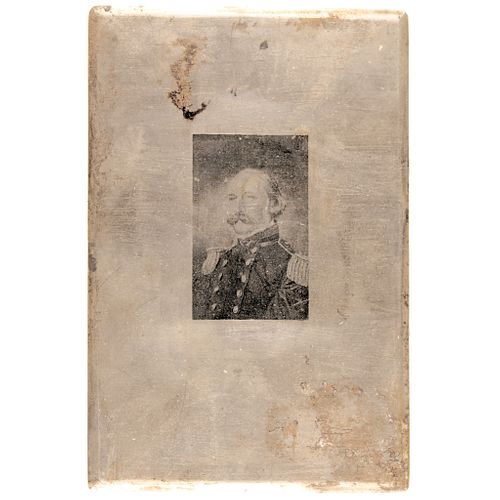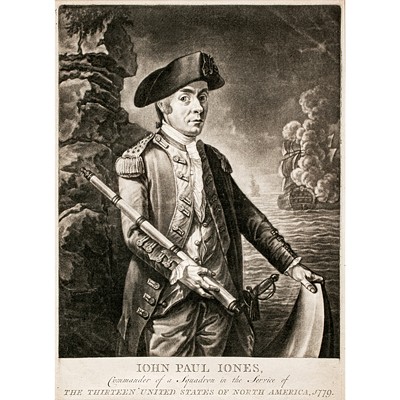c.1860, William David Porter-Steel Printing Plate
Lot 172
Categories
Estimate:
$900 - $1,200
Absentee vs Live bid
Two ways to bid:
- Leave a max absentee bid and the platform will bid on your behalf up to your maximum bid during the live auction.
- Bid live during the auction and your bids will be submitted real-time to the auctioneer.
Bid Increments
| Price | Bid Increment |
|---|---|
| $0 | $10 |
| $200 | $20 |
| $300 | $25 |
| $500 | $50 |
| $1,000 | $100 |
| $2,000 | $200 |
| $3,000 | $250 |
| $5,000 | $500 |
| $10,000 | $1,000 |
| $20,000 | $2,000 |
| $30,000 | $2,500 |
| $50,000 | $5,000 |
| $100,000 | $10,000 |
| $200,000 | $20,000 |
| $300,000 | $25,000 |
| $500,000 | $50,000 |
About Auction
By Early American History Auctions
Jan 23, 2021
Set Reminder
2021-01-23 12:00:00
2021-01-23 12:00:00
America/New_York
Bidsquare
Bidsquare : Early American History Auction of Autographs, Americana, Political & Maps
https://www.bidsquare.com/auctions/early-american-history-auctions/early-american-history-auction-of-autographs-americana-political-maps-6311
311 Lots of Rare, Historic Autographs, Americana, Civil War Era, George Washington, Abraham Lincoln, Slavery & Black History, Revolutionary War Era, Colonial America, Federal Period, War of 1812, Colonial Currency, Indian Peace Medals & more... Early American History Auctions auctions@earlyamerican.com
311 Lots of Rare, Historic Autographs, Americana, Civil War Era, George Washington, Abraham Lincoln, Slavery & Black History, Revolutionary War Era, Colonial America, Federal Period, War of 1812, Colonial Currency, Indian Peace Medals & more... Early American History Auctions auctions@earlyamerican.com
- Lot Description
Civil War Prints
Admiral CHARLES HENRY DAVIS Original Steel Printing Plate Engraved by Dexter Photo Co. Hartford
c. 1860s Civil War era, mid-19th Century Engraved Steel Printing Plate, Protrait Image of Civil War Union Naval Commander Admiral CHARLES HENRY DAVIS was Engraved by J. C. Dexter Photo Co., of Hartford, CT, Fine.
This original, 9.5" tall x 6" wide extremely rare (if not Unique), Engraved Printing Plate remains in good condition with overall moderate wear from use, with some minor rust and trivial surface roughness that is mostly well away from the central engraved image of Admiral Davis. There is no date or place inscription. This steel engraved plate remains in good overall condition with some moderate wear from use, and has some marginal rust outside of and away from the actual image portion. It was apparently used to produce a photographic image of Charles Henry Davis, most probably for a Civil War related book.
Charles Henry Davis directed operations of the Coast Survey along the New England coast, established the "American Ephemeris and Nautical Almanac" in 1849 and published several hydrographic studies. He is best remembered however, for his brilliant service in the Civil War. In 1861, he was fleet captain in the successful expedition against Port Royal, S.C. In 1862, Davis replaced A. H. Foote in command of the Upper Mississippi flotilla of gunboats. The day after assuming command he repulsed the attack of a Confederate fleet near Fort Pillow. The following month he annihilated the Confederate fleet before Memphis, taking the city the same day. In recognition of his important victories, Davis was promoted to rear admiral in 1863.
Here, Davis's engraved portrait appears in his Naval uniform. All in all, this rare plate remains very presentable. It is accompanied by its original housing envelope.
Charles Henry Davis (1807-1877) was a Rear Admiral in the U.S. Navy, serving primarily during the Civil War and with the United States Coast Survey. Davis was born in Boston, Massachusetts and commissioned as a Midshipman on August 12th, 1823. He served for a time in the Pacific on board the frigate USS United States. In 1829, he was promoted to Passed Midshipman, then served on the sloop USS Ontario. In 1834, he was promoted to Lieutenant and assigned first to the USS Vincennes and then to the USS Independence.
From 1846 to 1849, he worked in the United States Coast Survey on board the USS Nantucket, where he discovered a previously unknown shoal that had caused numerous shipwrecks off the coast of New York. During his service to the Survey, he was also responsible for researching tides and currents and acted as an inspector on a number of naval shipyards. In 1854, Davis was promoted to Commander and given the command of the USS St. Mary's. In 1859, he was ordered to go to Baker Island to obtain samples of guano, becoming perhaps the first American to set foot there since it was annexed by the United States in 1857. The guano was necessary as fertilizer. Commodore William Mervine had previously been sent but did not land, believing the island to be inaccessible.
In 1861, he was promoted to Captain and during the Civil War he was made Acting Flag Officer, in command of the Western Gunboat Flotilla. A day after he took command, the flotilla fought a battle with Confederate ships on the Mississippi River at Plum Point Bend on May 10th, 1862. Caught unready for battle, two of the Union ships were badly damaged and had to be run into shoal water to keep from sinking. The Confederate vessels escaped with only minor damage. On June 6th, his ships fought in the Battle of Memphis, which resulted in the sinking or capture of seven of the eight Confederate ships, compared with damage to only one of the Union vessels. In July, he cooperated with Flag Officer David G. Farragut in an attack on Vicksburg, Mississippi, but they were forced to withdraw. In August, he proceeded up the Yazoo River and successfully seized Confederate supplies and munitions there.
Following this excursion, he was made Chief of the Bureau of Navigation and returned to Washington, D.C. On February 7th, 1863, he was promoted to Rear Admiral. From 1865 to 1867, he was the Superintendent of the United States Naval Observatory. In 1867, he was given command of the South Atlantic squadron and was given the USS Guerriere as his flagship. In 1869, he returned home and served both on the Lighthouse Board as well as in the Naval Observatory. A species of sea anemone native to the coasts of New England and Nova Scotia, the Rhodactis davisii, is named for Davis. Several ships of the United States Navy are also named in his honor
- Shipping Info
-
Early American provides in-house worldwide shipping. Please contact us directly if you have questions about your specific shipping requirements.
-
- Buyer's Premium



 EUR
EUR CAD
CAD AUD
AUD GBP
GBP MXN
MXN HKD
HKD CNY
CNY MYR
MYR SEK
SEK SGD
SGD CHF
CHF THB
THB












